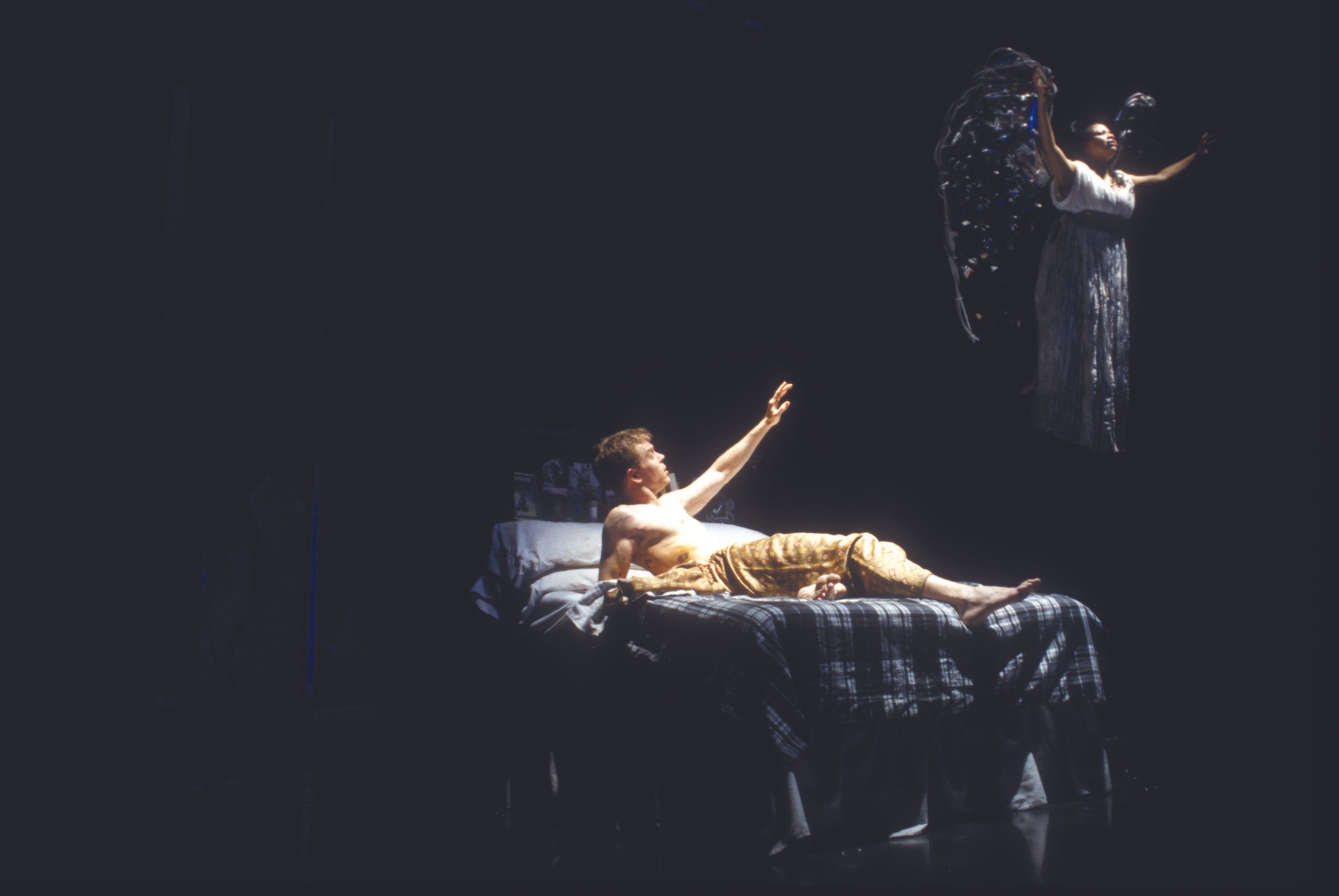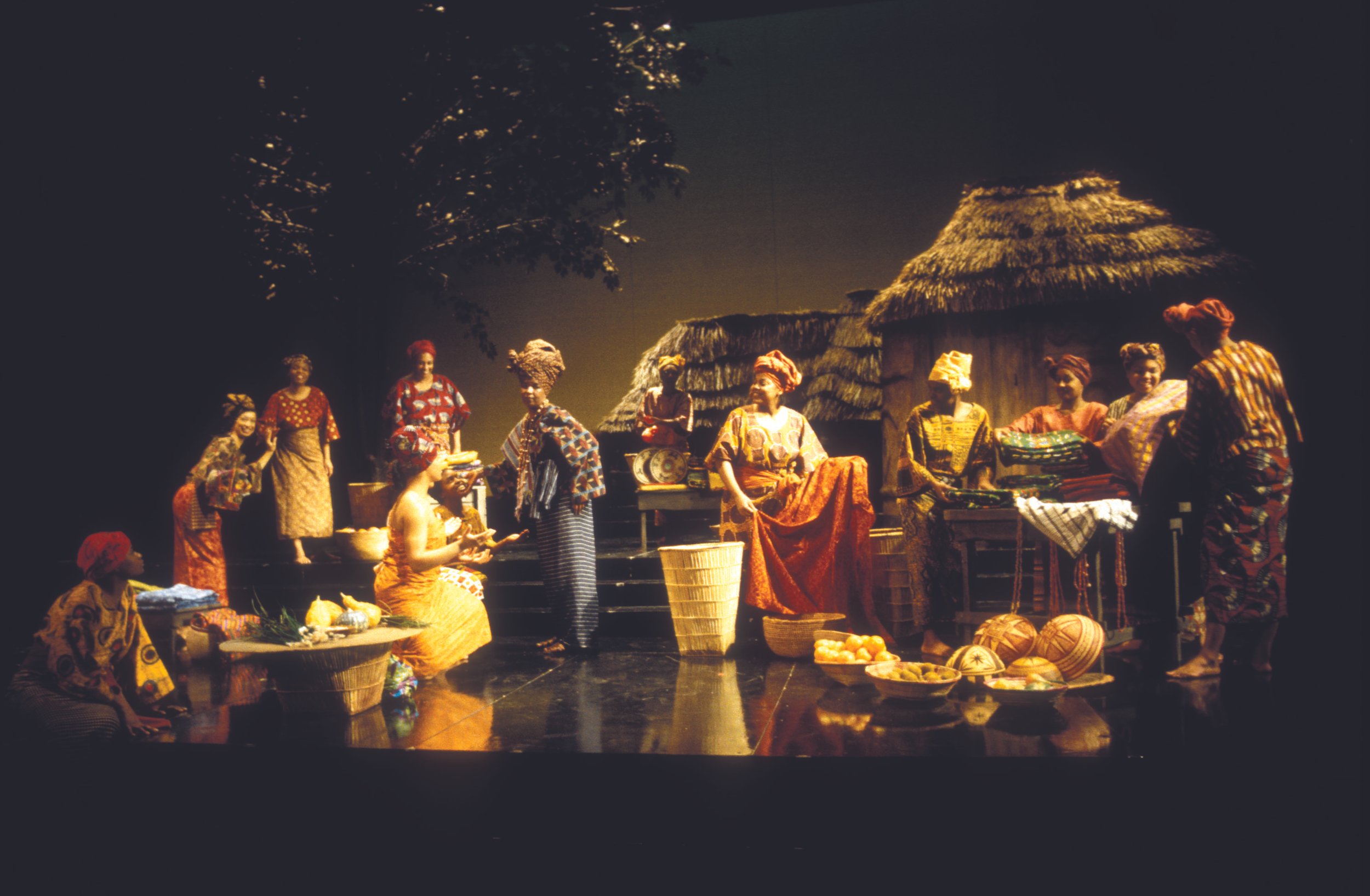
STAGE AS WE KNOW IT
Leslie Lyles in Willy Russel’s Shirley Valentine. Season: 1996 – 1997. Director: Robert Moss
For fifteen seasons Robert Moss had been the artistic director of the Hangar Theatre in Ithaca, New York. The Hangar was just the latest stop in a career that stretched back to the legendary APA Repertory Company headed by Ellis Rabb and starring such luminaries of the stage as Helen Hayes, Rosemary Harris, Donald Moffat, and Nancy Marchand. Moss was also the founder of Playwrights Horizons in New York, serving as producing director for ten years and then as director of the Playwrights Horizons Theatre School, an affiliate of New York University’s Tisch School of the Arts. During his tenure as producing director, Playwrights Horizons produced new works by more than 150 writers including Wendy Wasserstein, Albert Innaurato, James Lapine, and William Finn. Moss was also the founder of the Forty-Second Street Gang, the agency behind the renovation and creation of 42nd Street’s Theatre Row. In addition, Moss had directed at such regional theatres as The McCarter, The Old Globe, and Equity Library Theatre, and had served on boards and panels from The Theatre Communications Group to the National Endowment for the Arts. In what could certainly qualify as an understatement, search committee chair Lowell Seifter told The Daily Orange, “Moss’s professional experience, enthusiasm, and New York connections were part of what got him hired at Syracuse Stage.”
It didn’t take long for the Syracuse community to get a good sense of that enthusiasm. Ever approachable and eager to talk shop, Moss regularly stopped to chat with patrons in the lobby, on the street, or most famously, in the aisles of Wegmans. He was a natural ambassador of theatrical good will and an effortless and tireless champion of Syracuse Stage. Seemingly overnight, the phrase “I saw Bob Moss at Wegmans and he said . . .” became commonplace in casual conversation.
“It’s one of Bob’s rules. Don’t waste your life. I think what this play says is: At any single moment in your life, you can reinvent your life…”
Moss’s directorial debut in the 1996/97 season was Willy Russell’s Shirley Valentine, starring Leslie Lyles. In an interview with artistic associate Carlyn Ann Aqualine, Moss explained why the play appealed to him, and in doing so, expressed the optimism that characterized his approach to theatre. “It’s one of Bob’s rules. Don’t waste your life. I think what this play says is: At any single moment in your life, you can reinvent your life. You can reinvent if you want to. Sometimes it takes a herculean act of will, but, I mean, Shirley talks about how we’re given this life and we waste it, and so she resolves not to waste any more of it. So, I think it has an enormous amount to say and I’m very moved by it.”
Amanda Butterbaugh as Peter Pan and Rodney Hudson as Captain Hook in J.M. Barrie’s Peter Pan. Season: 2000 - 2001.
Moss’s tenure was marked by notable firsts for Syracuse Stage as well for outstanding onstage productions, some of which remain among the most memorable in the company’s history. In the 2000/2001 season, Syracuse Stage introduced the annual co-production with the Department of Drama. First up was the musical adaptation of J.M. Barrie’s Peter Pan, directed and choreographed by faculty member Anthony Salatino with musical direction by Dianne Adams McDowell. “There never has been anything like it in 28 seasons of Syracuse Stage—a lavish musical with Broadway-size sets and cast,” wrote Joan E. Vadeboncoeur in The Post Standard.
Salatino and McDowell would figure prominently in the early development of the co-pros, working on nine of the first ten. Since that inaugural production, the co-pros have become integral to the partnership between Syracuse Stage and the Department of Drama and a much-anticipated annual holiday tradition for the Syracuse community. Salatino and McDowell were equally instrumental in the creation of Stage’s first original musical, a theatre for young audiences adaptation of The Wind in the Willows. With a book by Drama faculty member Gerardine Clark, who co-directed with Salatino, and music by McDowell and her husband James, Wind in the Willows closed the 1996/1997 season before moving to a successful run at New York’s New Victory Theatre.
The 1997/1998 season marked Stage’s 25th anniversary and a return of Drama alumnus and favorite son Aaron Sorkin. Moss directed Sorkin’s Broadway hit A Few Good Men as the celebratory season opener and the acclaimed playwright attended opening night. In a program note, Sorkin wrote: “I’m proud of my connection to Syracuse Stage and grateful for the experience, education, and fraternity that it’s given me . . . I’m honored that Bob Moss and Jim Clark have chosen my play to open the 25th Anniversary Season. It’s nice to be home.”
Cast members in Aaron Sorkin’s A Few Good Men. Season: 1997 - 1998

"Angels in America" production photo 1997/1998

"Death and the King's Horseman." 1999
In the same season Moss directed Tony Kushner’s monumental Angels in America, Part 1: Millennium Approaches. In order to give audiences the chance to experience the entire sweep of Kushner’s work, Moss also staged a limited-run workshop production of Angels in America, Part 2: Peristroika, featuring the same cast. Jim Clark recalls that at the first performance of Peristroika, as the actors took the stage books in hand, the audience greeted them with a standing ovation in recognition of their work in Millennium Approaches.
Nigerian Nobel Laureate Wole Soyinka’s Death and the King’s Horseman was the centerpiece of the 1998/99 season and another highlight of Moss’s tenure. Directed by Marion McClinton, who had appeared in August Wilson’s Fences in 1991, the play featured Roger Robinson in the lead role of Elesin. Robinson had been a member of the Syracuse Repertory Theatre in 1967 when he appeared in William Hanley’s Slow Dance on the Killing Ground. He also appeared in much of the 1968 season as well. The large cast of Death and the King’s Horseman included a troupe of local dancers who portrayed the women of the village and performed choreography by Emmy-nominated Dianne McIntyre. ASCAP Award-winner Kysia Bostic composed and arranged the music, some of which was performed by master drummer Adebisi Adeleke and drummer Adesina Odukoya. Soyinka, who was awarded the Noble Prize for Literature in 1986, attended a performance and met with Drama students for a lengthy question and answer session.
Elizabeth Franz and Sam Waterston in Eugene O’Neill’s Long Days Journey into Night. Season: 1999 - 2000
A chance opportunity at the conclusion of the 1999/2000 season led to one of the most memorable productions in Stage’s history, a star driven production of Eugene O’Neill’s Long Day’s Journey into Night. Phil Monat was a lighting designer who worked frequently at Stage. While in rehearsal for the season closer, A Raisin in the Sun directed by Claude Purdy, Monat mentioned to Moss that actor Sam Waterston was interested in mounting a production of Eugene O’Neill’s Long Day’s Journey into Night. Monat wondered if Moss might be interested in producing it at Syracuse Stage. It would mean adding a show to the season on short notice, but the opportunity seemed too good to pass up. Moss and Clark pursued it.
At the time Monat first mentioned the project to Moss, certain aspects of the production had already been determined. Waterston would play James Tyrone, the character based on James O’Neill, the playwright’s father. Waterston’s son James would play Edmund, the character based on Eugene O’Neill himself. New York-based director Kent Paul was also on board, but the pivotal roles of Mary and elder son Jamie had not been cast. For a couple of weeks, the search to fill those roles created an exciting buzz around Syracuse Stage as rumor fed speculation about who might join the cast. Then Broadway veteran and Tony Award-winner Elizabeth Franz agreed to play Mary, and John Slattery (later of Mad Men fame) signed on as the elder son Jamie. Recent Department of Drama graduate Kim Gatewood completed the cast as the maid Cathleen. Long Day’s Journey into Night ran for five weeks with many performances sold out.
In the seasons ahead Stage would welcome two revered performers. Multi-Emmy Award-winner Jean Stapleton returned as Eleanor Roosevelt in the one-woman show Eleanor: Her Secret Journey by Rhoda Lerman. As in her previous appearance at Stage, Stapleton sold out all performances even before the show opened. In 2004, stage, film and television actor Ben Gazzara opened the season in Tom Lysaght’s Nobody Don’t Like Yogi, a one-man play about the accidental sage and legendary Yankee catcher. In a distinguished career, Gazzara was best known for originating the role of Brick in the Broadway premiere of Tennessee Willaims’s Cat on a Hot Tin Roof as well as for his work several films by John Cassavetes.
In 2002, Michael Donald Edwards was named Stage’s first associate artistic director. With an extensive resumé spanning opera and theatre, Edwards proved an adept artistic partner for Moss. Together, they directed most of the shows in the following four seasons with talented visiting director Timothy Douglas contributing a handful of very strong productions. Tazewell Thompson, too, returned in the 2003/2004 season with his music filled Constant Star.
Cast members of Constant Star. Season: 2003 - 2004. Photo: Alex Ottaviano
In 2006, Moss and Jim Clark announced that were retiring from Stage. The same year, Edwards became the producing artistic director of Florida’s Asolo Repertory Theatre. Although Clark had been at Stage for 30 years and Moss for ten, the announcement still took many by surprise. “Bob and I had been talking to each other about our future plans for some time now,” Clark said at the time. “Over the course of those private conversations, we began to realize that we were thinking along the same timeline.” Moss concurred. “Jim’s thinking absolutely dovetailed with mine. I’ve been here for ten years and in professional theatre for nearly fifty. Jim has been with Syracuse Stage for thirty years. We shared the sense that it was time. I’m proud of what Syracuse Stage is, and what it means to the Central New York community.”
Moss and Clark agreed to stay until searches had been completed for their replacements. This commitment guaranteed artistic continuity through the upcoming seasons and eased the transition to new leadership. One of the goals of that transition was to reorganize the leadership structure and turn two positions into three. Clark had served as producing director of Stage and chair of the Department of Drama. Moss had been the artistic director of Stage. In this structure, Clark was responsible for the day-to-day operations of Stage and the academic and artistic direction of the Department of Drama. Moss was the artistic leader for Stage. The new model proposed one person to serve as producing artistic director for Stage and Drama and provide artistic leadership for both entities, much as Arthur Storch had done. A second person would become the managing director for Stage and assume responsibility for day-to-day operations and administration. The third position would be a new chair of the Department of Drama to oversee curricula and academic matters.





